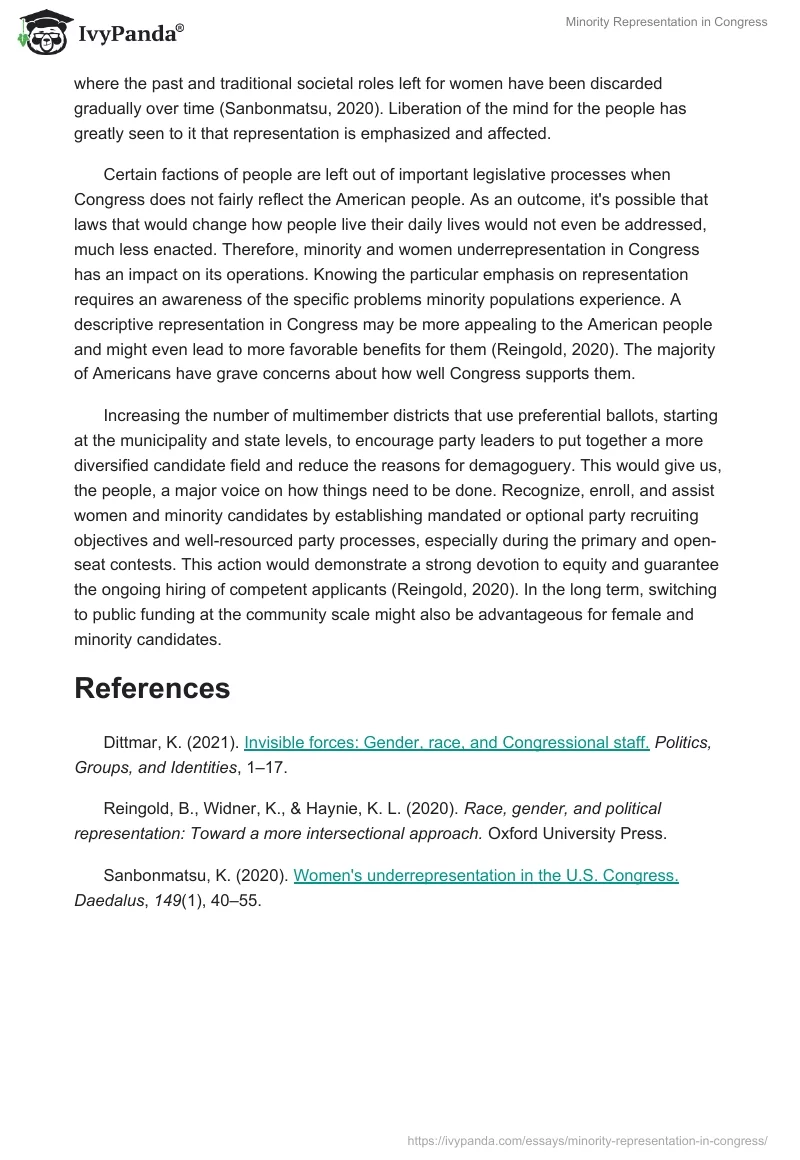The idea of representation is complicated. It could entail being attentive to voters’ concerns and realizing that elected officials must make decisions depending on what they believe is appropriate for the constituency or depending on the distinct culture, racial, or sexual identity of individuals already in office (Reingold, 2020). In other instances, it may appear that representation has nothing to do with the important topics that members of Congress typically debate. The racial, ethnic, social, gender, and gender identification of the members themselves serve as the foundation for good representation for some (Reingold, 2020). Descriptive representation is the name given to this type of representation.
The present government is by far the most racially and multiethnic ever, contrary to history. 124 representatives—representing 23% of Congress, 26% of the House of Representatives and 11% of the Senate—identify as Black, Hispanic, Asian/Pacific American, or Native American (Dittmar, 2021). Although the diversity of race and ethnicity in Congress is increasing, it is still less varied than the country in its entirety. The estimated LGBTQ population in America is over 4.5 percent, yet just approximately 2% of Congress is openly gay (Dittmar, 2021). One important factor is that white men of European descent made up the vast majority of voters up to the middle of the 20th century. Hispanics and other minority groups were disproportionately underrepresented in state legislatures, and African Americans were often denied the right to vote. Past statutes and regulations towards the LGBTQ+ community forbade gay relations sans specifically mentioning homosexuality (Dittmar, 2021). This is why most groups tend to be underrepresented.
There are more women in Congress than ever before. There are 144 women in the national parliament, making up a historic 27% of all members in both chambers (Sanbonmatsu, 2020). It comprises of 24 women in the Senate and a remarkable 120 women who are now serving in the House. Since the 1920s, there has been a slow but continuous rise in the percentage of women serving in the House (Sanbonmatsu, 2020). This continuous trend of representation for both women and minorities has been a result of the need to boost Congress’s performance and better serve a broad range of people they represent, which will ultimately help Congress regain the trust of those they represent (Sanbonmatsu, 2020). This can be attributed to the progress in social living, where the past and traditional societal roles left for women have been discarded gradually over time (Sanbonmatsu, 2020). Liberation of the mind for the people has greatly seen to it that representation is emphasized and affected.
Certain factions of people are left out of important legislative processes when Congress does not fairly reflect the American people. As an outcome, it’s possible that laws that would change how people live their daily lives would not even be addressed, much less enacted. Therefore, minority and women underrepresentation in Congress has an impact on its operations. Knowing the particular emphasis on representation requires an awareness of the specific problems minority populations experience. A descriptive representation in Congress may be more appealing to the American people and might even lead to more favorable benefits for them (Reingold, 2020). The majority of Americans have grave concerns about how well Congress supports them.
Increasing the number of multimember districts that use preferential ballots, starting at the municipality and state levels, to encourage party leaders to put together a more diversified candidate field and reduce the reasons for demagoguery. This would give us, the people, a major voice on how things need to be done. Recognize, enroll, and assist women and minority candidates by establishing mandated or optional party recruiting objectives and well-resourced party processes, especially during the primary and open-seat contests. This action would demonstrate a strong devotion to equity and guarantee the ongoing hiring of competent applicants (Reingold, 2020). In the long term, switching to public funding at the community scale might also be advantageous for female and minority candidates.
References
Dittmar, K. (2021). Invisible forces: Gender, race, and Congressional staff.Politics, Groups, and Identities, 1–17.
Reingold, B., Widner, K., & Haynie, K. L. (2020). Race, gender, and political representation: Toward a more intersectional approach. Oxford University Press.
Sanbonmatsu, K. (2020). Women’s underrepresentation in the U.S. Congress.Daedalus, 149(1), 40–55.


